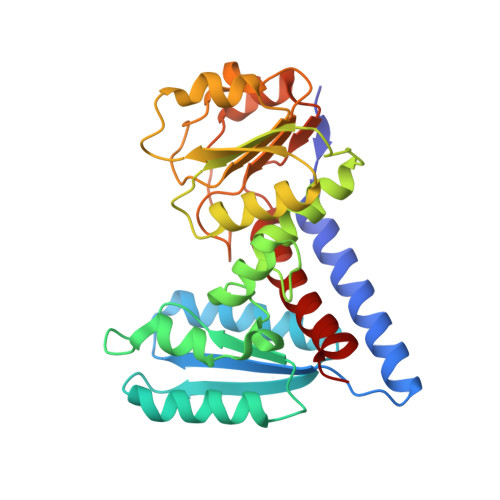Assessment of Pseudomonas Aeruginosa N(5),N(10)-Methylenetetrahydrofolate Dehydrogenase - Cyclohydrolase as a Potential Antibacterial Drug Target.
Eadsforth, T.C., Gardiner, M., Maluf, F.V., Mcelroy, S., James, D., Frearson, J., Gray, D., Hunter, W.N.(2012) PLoS One 7: 35973
- PubMed: 22558288
- DOI: https://doi.org/10.1371/journal.pone.0035973
- Primary Citation of Related Structures:
4A5O - PubMed Abstract:
The bifunctional enzyme methylenetetrahydrofolate dehydrogenase - cyclohydrolase (FolD) is identified as a potential drug target in Gram-negative bacteria, in particular the troublesome Pseudomonas aeruginosa. In order to provide a comprehensive and realistic assessment of the potential of this target for drug discovery we generated a highly efficient recombinant protein production system and purification protocol, characterized the enzyme, carried out screening of two commercial compound libraries by differential scanning fluorimetry, developed a high-throughput enzyme assay and prosecuted a screening campaign against almost 80,000 compounds. The crystal structure of P. aeruginosa FolD was determined at 2.2 Å resolution and provided a template for an assessment of druggability and for modelling of ligand complexes as well as for comparisons with the human enzyme. New FolD inhibitors were identified and characterized but the weak levels of enzyme inhibition suggest that these compounds are not optimal starting points for future development. Furthermore, the close similarity of the bacterial and human enzyme structures suggest that selective inhibition might be difficult to attain. In conclusion, although the preliminary biological data indicates that FolD represents a valuable target for the development of new antibacterial drugs, indeed spurred us to investigate it, our screening results and structural data suggest that this would be a difficult enzyme to target with respect to developing the appropriate lead molecules required to underpin a serious drug discovery effort.
- Division of Biological Chemistry and Drug Discovery, College of Life Sciences, University of Dundee, Dundee, United Kingdom.
Organizational Affiliation:


















